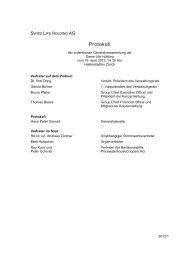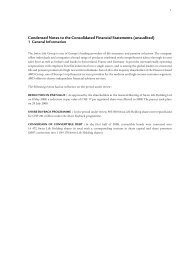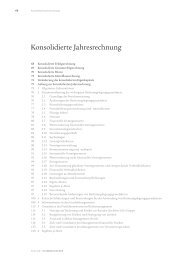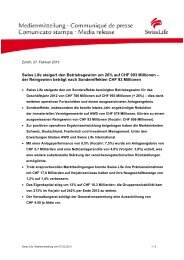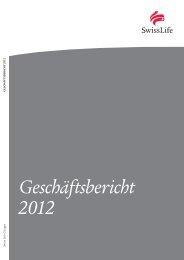Annual Report 2012 - Swiss Life
Annual Report 2012 - Swiss Life
Annual Report 2012 - Swiss Life
Create successful ePaper yourself
Turn your PDF publications into a flip-book with our unique Google optimized e-Paper software.
In CHF million<br />
31.12.<strong>2012</strong> 31.12.2011<br />
163 Consolidated Financial Statements<br />
with a reliable pricing basis with sufficient statistical data available. Insurance risk arises when biometric<br />
parameters deviate adversely from expectations. The uncertainty in the estimation of future benefit<br />
payments and premium receipts for long-term insurance contracts is due to the unpredictability of<br />
long-term changes in overall levels of mortality and disability, for instance. Furthermore, deviations<br />
from the expected outcome of a portfolio can also arise because of random fluctuations. The impact<br />
of random fluctuations depends on the extent of diversification within a portfolio of contracts, that<br />
is, on the size of the portfolio.<br />
The quantification of life insurance risk is based on a sensitivity analysis. Insurance risk is thus measured<br />
as the deviation of (the realisations of) the insurance risk factors from the corresponding best<br />
estimate values. <strong>Life</strong> insurance risk factors include mortality rates, disability rates and longevity,<br />
among others.<br />
The nature of insurance risk can be summarised as follows:<br />
Mortality and longevity<br />
Mortality and longevity risks respectively reflect the financial consequences of insured people dying<br />
sooner or living longer than expected. For example, a life insurer with an annuity portfolio making<br />
payments to the policyholders until their death is financially exposed to those individuals who live<br />
longer than expected. Conversely, an insurer writing life insurance business that pays out amounts<br />
contingent on death of the policyholders is exposed to increases in mortality levels.<br />
In Switzerland, the <strong>Swiss</strong> occupational pensions (BVG) segment of the group life insurance business<br />
is a significant part of the Group’s overall life insurance business. The BVG business provides an<br />
example of a minimum return guarantee. The guarantee takes the form of the right to convert an<br />
assured sum into a life annuity at a guaranteed conversion rate: The prevalent annuity conversion<br />
rate for the mandatory part of the BVG business is set at 6.85% for men (retirement age 65) and 6.8%<br />
for women (retirement age 64) for retirements in 2013 (6.9% for men and 6.85% for women for retirements<br />
in <strong>2012</strong>). Under an amendment to the BVG legislation, which took effect on 1 January 2005, the<br />
rate will be reduced in stages to 6.8% by 2014.<br />
With regard to mortality, morbidity and longevity risk the most important annuities payable (annuities<br />
in payment phase) or insured (annuities in deferral phase) as well as sums insured are as follows:<br />
Annuities payable per annum by type of annuity – individual life<br />
<strong>Life</strong> annuities – in payment 604 570<br />
<strong>Life</strong> annuities – deferred 1 615 1 192<br />
Annuities certain – in payment 17 16<br />
Annuities certain – deferred 45 47<br />
Disability income and other annuities – in payment 228 232<br />
Disability income and other annuities – deferred 7 598 7 661<br />
Total individual life 10 106 9 718<br />
<strong>Swiss</strong> <strong>Life</strong> – <strong>Annual</strong> <strong>Report</strong> <strong>2012</strong>



